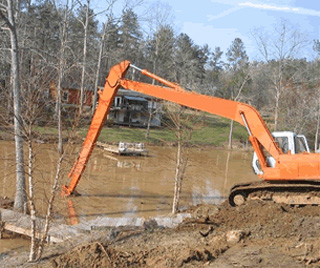Shoreline
Public Lands Act

The beds of most lakes, rivers and some streams are considered to be Crown land. Crown land is generally that portion of a lake or river below the high water level. However, lakes in which the water levels are controlled by a dam are more complicated. Depending on the date the dam was constructed, some of the flooded lands may be under private ownership. The Public Lands Act does not apply to lands that are privately owned. Conservation Authority regulations may still apply to flooded privately owned lands and the near shore area of the lake would be considered fish habitat. A stream bed is considered to be Crown land if the stream is deemed to be navigable .Beds of Navigable Waters Act navigability can be difficult to determine in some cases and an opinion from the Surveyor General’s office may be required. As a general guide, a stream is considered to be navigable if it can be used as an aqueous highway to travel between two access points. For example, if a canoe can be launched from a municipal bridge (road allowance) and used to travel without portaging to the next municipal bridge, then under most circumstances, that portion of stream would be considered navigable. It is always a good idea to contact your local MNRF office for advice. For more information on navigability read about MNRF’s policy on Ownership Determination – Beds of Navigable Waters and Tools for Identifying Navigable Lakes and Streams.
Works on or occupation of Crown land requires the approval of the MNRF through the issuance of a work permit. Work permits specify exactly what work is approved as well as the conditions and timelines for completing the work. Depending on what fish are found at the site, no in-water work is permitted during the time the fish are laying their eggs and the young fish are developing. Fisheries and Oceans Canada provides guidelines or Timing Windows for in water construction activities that have been put in place to protect fish habitat. Your local Conservation Authority or the MNRF can also advise you of any timing restrictions for in water construction. Follow the link to learn all about the Work Permit Application Process.
Examples of works that require a work permit include: placing fill in the water so that it covers an area greater than 15 square metres, dredging material from the shore lands to deepen a boating channel and the placement of a dock or boat house on the bed of a lake. It should be noted that a dock on pilings and floating docks do not require a work permit. Follow the link for more examples of when a work permit is required.
Follow this link to review the Full List of Crown Land Policies.
Regulation for Development, Interference with Wetlands, and Alterations to Shorelines and Watercourses

Before you begin any work in a shoreline area, you will need to check with your local conservation authority to see if a permit is required. If your watershed is not managed by a conservation authority, check with your local Ministry of Natural Resources and Forestry office. Waterfront properties along the Rideau or Trent-Severn waterways fall under the jurisdiction of Parks Canada.
Waterfront activities requiring a permit include:
- Construction of any kind
- Altering a structure
- Removing or dumping any material
- Altering a watercourse
- Altering a Provincially Significant Wetland (or adjacent lands)
For more detailed information, please read this brochure published by Conservation Ontario.
Protecting Fish Habitat is an extension note which explains safe ways to work along your waterfront. The Department of Fisheries and Oceans provides information related to the Canada Fisheries Act and the protection of fish habitat.
Your local conservation authority can be found on the Conservation Ontario website.
Your local Ministry of Natural Resources and Forestry office can be found on the MNRF website. The Ontario government has several pieces of legislation that regulate work around water. A summary is provided in this Fact Sheet.
Parks Canada policies and work permits are available on their website.
This project was undertaken with the financial support of the Government of Canada. | Ce projet a été réalisé avec l’appui financier du gouvernement du Canada.
